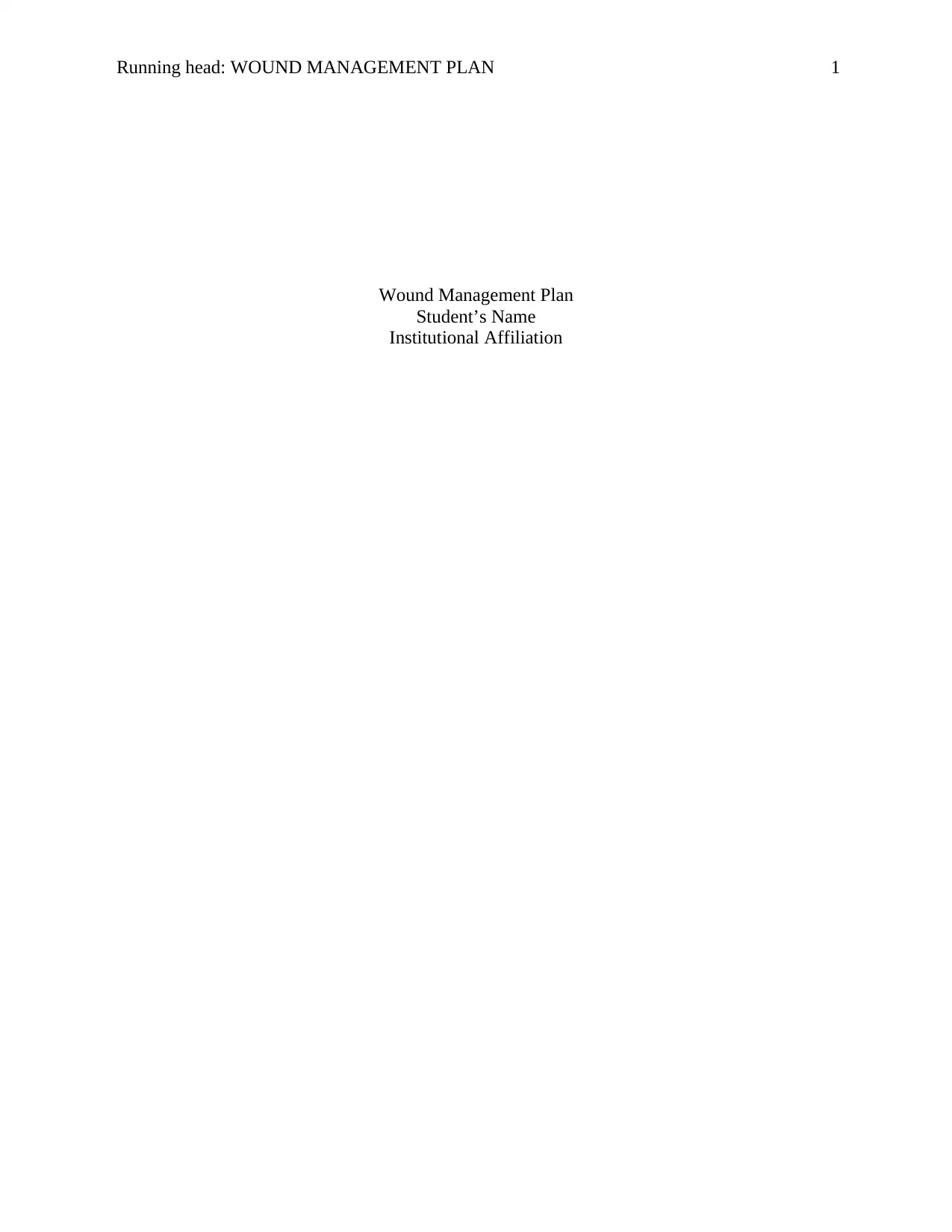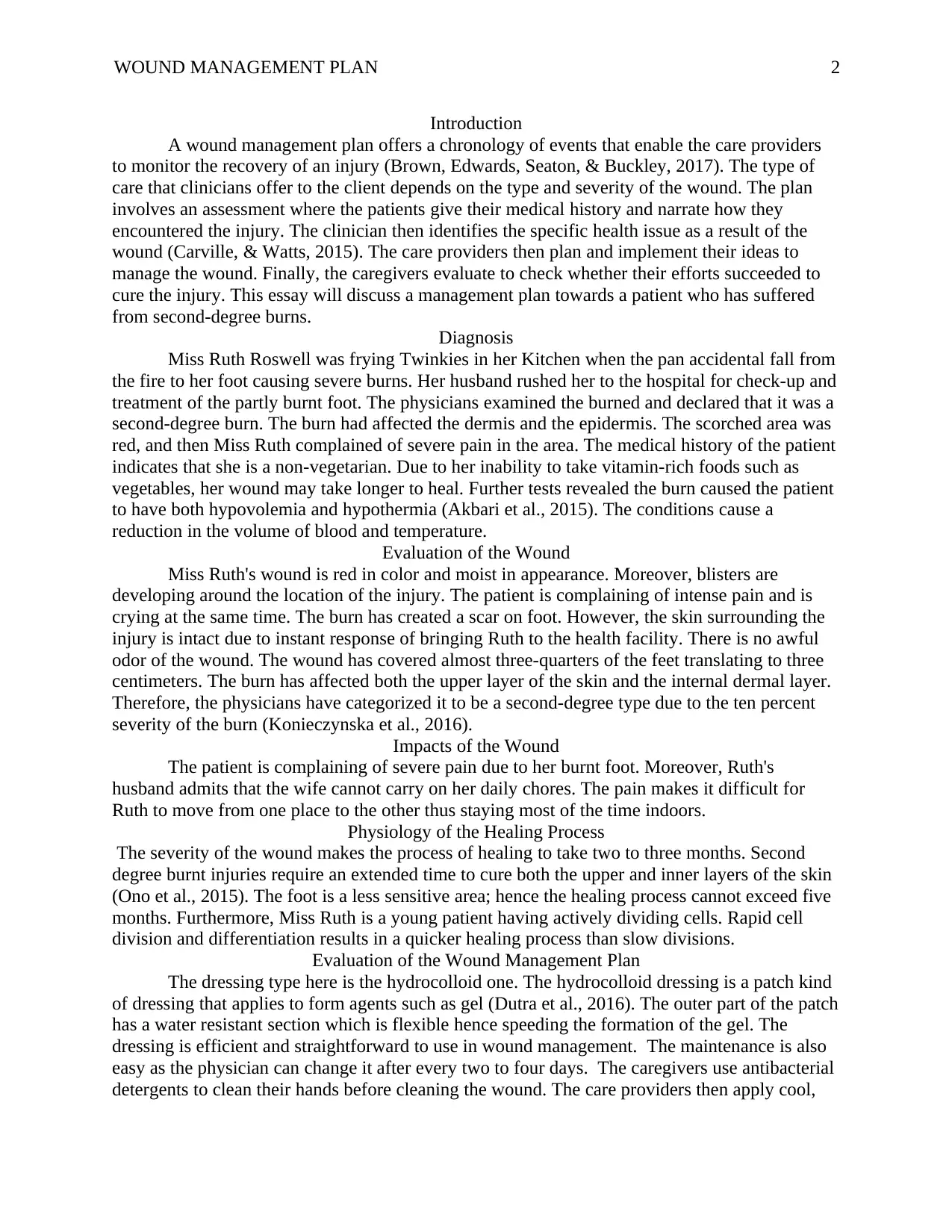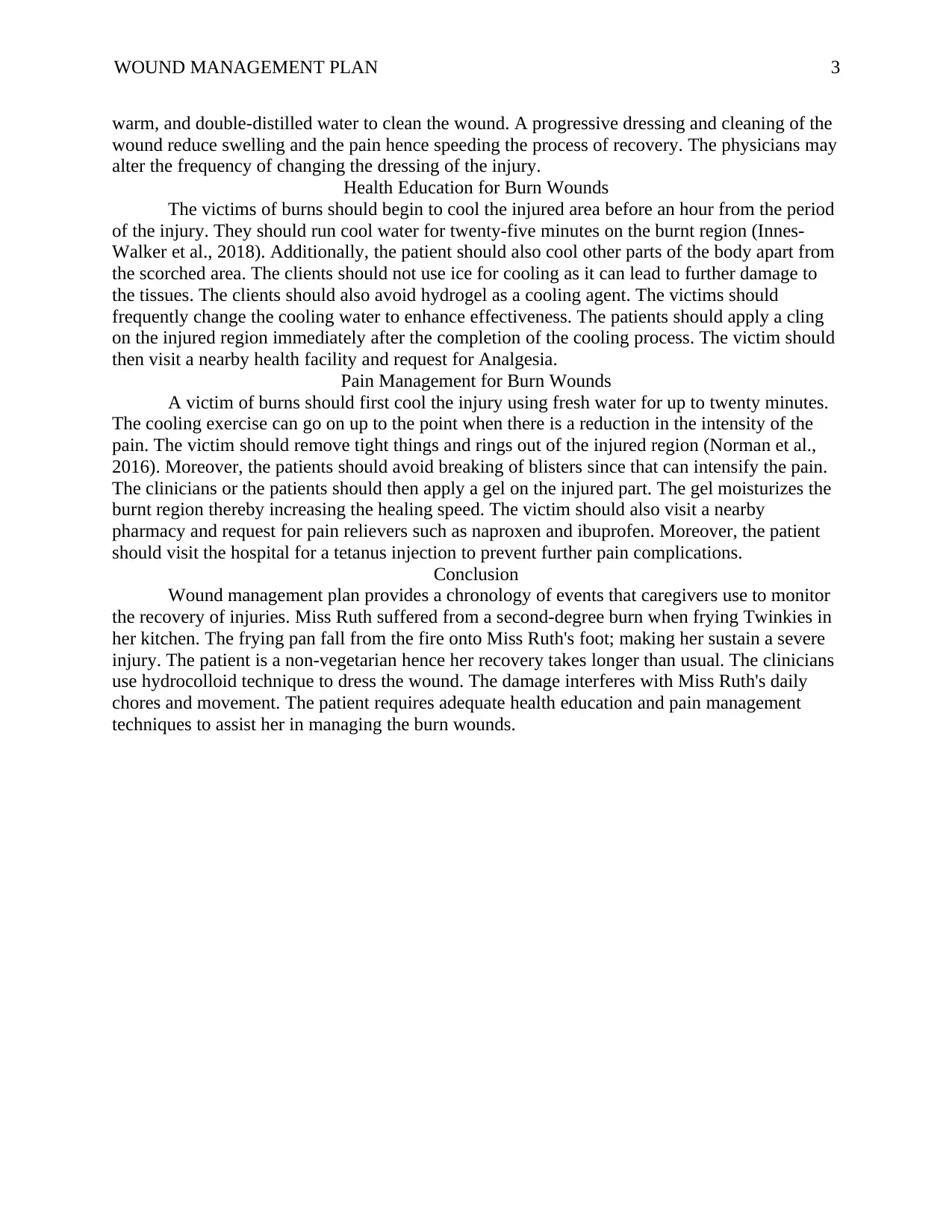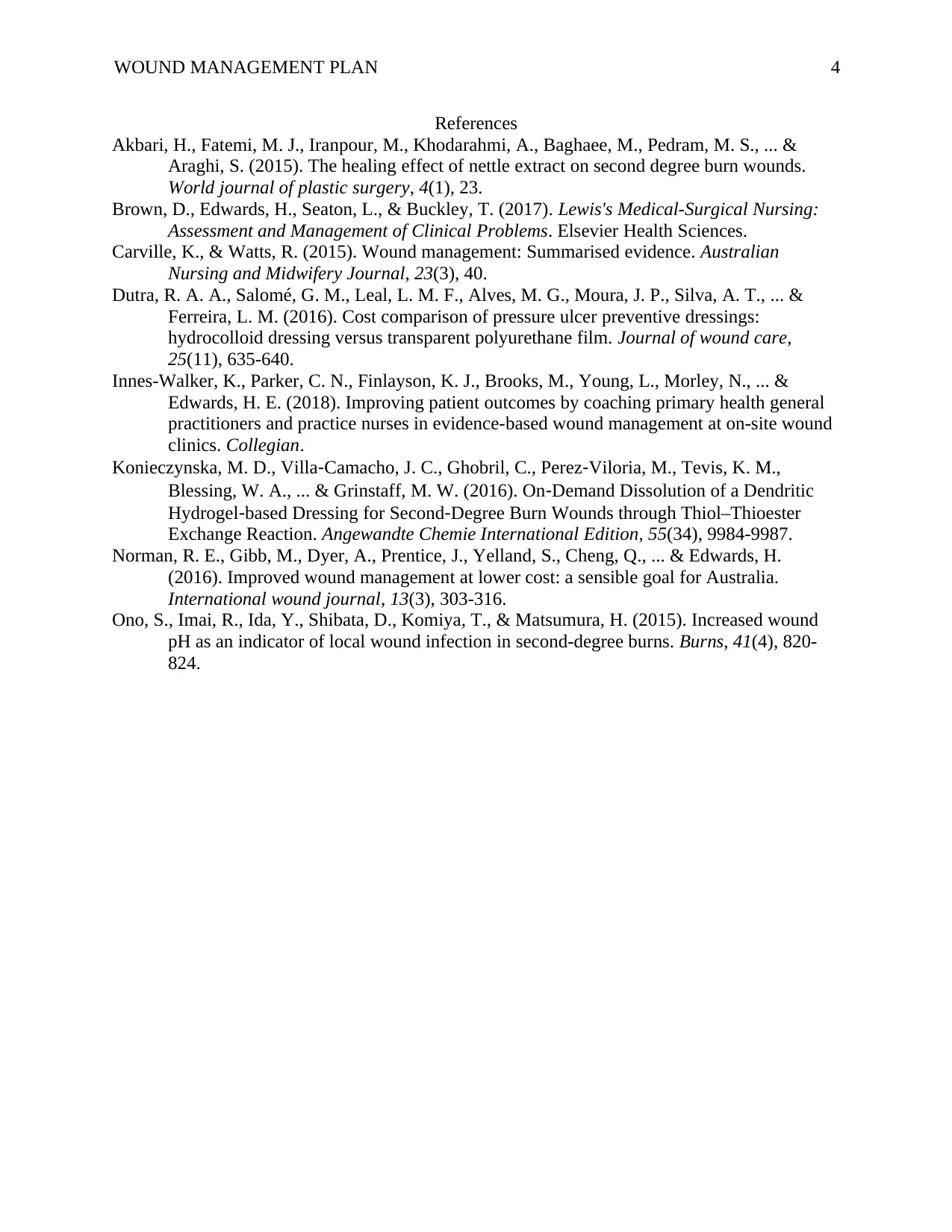Wound Management Plan: Clinical Environment Report
VerifiedAdded on 2023/06/10
|4
|1600
|325
Report
AI Summary
This report details a wound management plan for Miss Ruth Roswell, who suffered a second-degree burn from a kitchen accident. The plan includes an introduction to wound management principles, followed by a diagnosis of the burn, which affected both the epidermis and dermis. The evaluation of the wound describes its characteristics, the impacts on the patient, and the expected healing process, considering Miss Roswell's non-vegetarian diet. The plan outlines the use of hydrocolloid dressings, cleaning procedures, and health education for burn wounds, including pain management techniques like cooling the injury and using analgesics. The report concludes with a summary of the key aspects of the plan and references supporting literature.

Running head: WOUND MANAGEMENT PLAN 1
Wound Management Plan
Student’s Name
Institutional Affiliation
Wound Management Plan
Student’s Name
Institutional Affiliation
Paraphrase This Document
Need a fresh take? Get an instant paraphrase of this document with our AI Paraphraser

WOUND MANAGEMENT PLAN 2
Introduction
A wound management plan offers a chronology of events that enable the care providers
to monitor the recovery of an injury (Brown, Edwards, Seaton, & Buckley, 2017). The type of
care that clinicians offer to the client depends on the type and severity of the wound. The plan
involves an assessment where the patients give their medical history and narrate how they
encountered the injury. The clinician then identifies the specific health issue as a result of the
wound (Carville, & Watts, 2015). The care providers then plan and implement their ideas to
manage the wound. Finally, the caregivers evaluate to check whether their efforts succeeded to
cure the injury. This essay will discuss a management plan towards a patient who has suffered
from second-degree burns.
Diagnosis
Miss Ruth Roswell was frying Twinkies in her Kitchen when the pan accidental fall from
the fire to her foot causing severe burns. Her husband rushed her to the hospital for check-up and
treatment of the partly burnt foot. The physicians examined the burned and declared that it was a
second-degree burn. The burn had affected the dermis and the epidermis. The scorched area was
red, and then Miss Ruth complained of severe pain in the area. The medical history of the patient
indicates that she is a non-vegetarian. Due to her inability to take vitamin-rich foods such as
vegetables, her wound may take longer to heal. Further tests revealed the burn caused the patient
to have both hypovolemia and hypothermia (Akbari et al., 2015). The conditions cause a
reduction in the volume of blood and temperature.
Evaluation of the Wound
Miss Ruth's wound is red in color and moist in appearance. Moreover, blisters are
developing around the location of the injury. The patient is complaining of intense pain and is
crying at the same time. The burn has created a scar on foot. However, the skin surrounding the
injury is intact due to instant response of bringing Ruth to the health facility. There is no awful
odor of the wound. The wound has covered almost three-quarters of the feet translating to three
centimeters. The burn has affected both the upper layer of the skin and the internal dermal layer.
Therefore, the physicians have categorized it to be a second-degree type due to the ten percent
severity of the burn (Konieczynska et al., 2016).
Impacts of the Wound
The patient is complaining of severe pain due to her burnt foot. Moreover, Ruth's
husband admits that the wife cannot carry on her daily chores. The pain makes it difficult for
Ruth to move from one place to the other thus staying most of the time indoors.
Physiology of the Healing Process
The severity of the wound makes the process of healing to take two to three months. Second
degree burnt injuries require an extended time to cure both the upper and inner layers of the skin
(Ono et al., 2015). The foot is a less sensitive area; hence the healing process cannot exceed five
months. Furthermore, Miss Ruth is a young patient having actively dividing cells. Rapid cell
division and differentiation results in a quicker healing process than slow divisions.
Evaluation of the Wound Management Plan
The dressing type here is the hydrocolloid one. The hydrocolloid dressing is a patch kind
of dressing that applies to form agents such as gel (Dutra et al., 2016). The outer part of the patch
has a water resistant section which is flexible hence speeding the formation of the gel. The
dressing is efficient and straightforward to use in wound management. The maintenance is also
easy as the physician can change it after every two to four days. The caregivers use antibacterial
detergents to clean their hands before cleaning the wound. The care providers then apply cool,
Introduction
A wound management plan offers a chronology of events that enable the care providers
to monitor the recovery of an injury (Brown, Edwards, Seaton, & Buckley, 2017). The type of
care that clinicians offer to the client depends on the type and severity of the wound. The plan
involves an assessment where the patients give their medical history and narrate how they
encountered the injury. The clinician then identifies the specific health issue as a result of the
wound (Carville, & Watts, 2015). The care providers then plan and implement their ideas to
manage the wound. Finally, the caregivers evaluate to check whether their efforts succeeded to
cure the injury. This essay will discuss a management plan towards a patient who has suffered
from second-degree burns.
Diagnosis
Miss Ruth Roswell was frying Twinkies in her Kitchen when the pan accidental fall from
the fire to her foot causing severe burns. Her husband rushed her to the hospital for check-up and
treatment of the partly burnt foot. The physicians examined the burned and declared that it was a
second-degree burn. The burn had affected the dermis and the epidermis. The scorched area was
red, and then Miss Ruth complained of severe pain in the area. The medical history of the patient
indicates that she is a non-vegetarian. Due to her inability to take vitamin-rich foods such as
vegetables, her wound may take longer to heal. Further tests revealed the burn caused the patient
to have both hypovolemia and hypothermia (Akbari et al., 2015). The conditions cause a
reduction in the volume of blood and temperature.
Evaluation of the Wound
Miss Ruth's wound is red in color and moist in appearance. Moreover, blisters are
developing around the location of the injury. The patient is complaining of intense pain and is
crying at the same time. The burn has created a scar on foot. However, the skin surrounding the
injury is intact due to instant response of bringing Ruth to the health facility. There is no awful
odor of the wound. The wound has covered almost three-quarters of the feet translating to three
centimeters. The burn has affected both the upper layer of the skin and the internal dermal layer.
Therefore, the physicians have categorized it to be a second-degree type due to the ten percent
severity of the burn (Konieczynska et al., 2016).
Impacts of the Wound
The patient is complaining of severe pain due to her burnt foot. Moreover, Ruth's
husband admits that the wife cannot carry on her daily chores. The pain makes it difficult for
Ruth to move from one place to the other thus staying most of the time indoors.
Physiology of the Healing Process
The severity of the wound makes the process of healing to take two to three months. Second
degree burnt injuries require an extended time to cure both the upper and inner layers of the skin
(Ono et al., 2015). The foot is a less sensitive area; hence the healing process cannot exceed five
months. Furthermore, Miss Ruth is a young patient having actively dividing cells. Rapid cell
division and differentiation results in a quicker healing process than slow divisions.
Evaluation of the Wound Management Plan
The dressing type here is the hydrocolloid one. The hydrocolloid dressing is a patch kind
of dressing that applies to form agents such as gel (Dutra et al., 2016). The outer part of the patch
has a water resistant section which is flexible hence speeding the formation of the gel. The
dressing is efficient and straightforward to use in wound management. The maintenance is also
easy as the physician can change it after every two to four days. The caregivers use antibacterial
detergents to clean their hands before cleaning the wound. The care providers then apply cool,

WOUND MANAGEMENT PLAN 3
warm, and double-distilled water to clean the wound. A progressive dressing and cleaning of the
wound reduce swelling and the pain hence speeding the process of recovery. The physicians may
alter the frequency of changing the dressing of the injury.
Health Education for Burn Wounds
The victims of burns should begin to cool the injured area before an hour from the period
of the injury. They should run cool water for twenty-five minutes on the burnt region (Innes-
Walker et al., 2018). Additionally, the patient should also cool other parts of the body apart from
the scorched area. The clients should not use ice for cooling as it can lead to further damage to
the tissues. The clients should also avoid hydrogel as a cooling agent. The victims should
frequently change the cooling water to enhance effectiveness. The patients should apply a cling
on the injured region immediately after the completion of the cooling process. The victim should
then visit a nearby health facility and request for Analgesia.
Pain Management for Burn Wounds
A victim of burns should first cool the injury using fresh water for up to twenty minutes.
The cooling exercise can go on up to the point when there is a reduction in the intensity of the
pain. The victim should remove tight things and rings out of the injured region (Norman et al.,
2016). Moreover, the patients should avoid breaking of blisters since that can intensify the pain.
The clinicians or the patients should then apply a gel on the injured part. The gel moisturizes the
burnt region thereby increasing the healing speed. The victim should also visit a nearby
pharmacy and request for pain relievers such as naproxen and ibuprofen. Moreover, the patient
should visit the hospital for a tetanus injection to prevent further pain complications.
Conclusion
Wound management plan provides a chronology of events that caregivers use to monitor
the recovery of injuries. Miss Ruth suffered from a second-degree burn when frying Twinkies in
her kitchen. The frying pan fall from the fire onto Miss Ruth's foot; making her sustain a severe
injury. The patient is a non-vegetarian hence her recovery takes longer than usual. The clinicians
use hydrocolloid technique to dress the wound. The damage interferes with Miss Ruth's daily
chores and movement. The patient requires adequate health education and pain management
techniques to assist her in managing the burn wounds.
warm, and double-distilled water to clean the wound. A progressive dressing and cleaning of the
wound reduce swelling and the pain hence speeding the process of recovery. The physicians may
alter the frequency of changing the dressing of the injury.
Health Education for Burn Wounds
The victims of burns should begin to cool the injured area before an hour from the period
of the injury. They should run cool water for twenty-five minutes on the burnt region (Innes-
Walker et al., 2018). Additionally, the patient should also cool other parts of the body apart from
the scorched area. The clients should not use ice for cooling as it can lead to further damage to
the tissues. The clients should also avoid hydrogel as a cooling agent. The victims should
frequently change the cooling water to enhance effectiveness. The patients should apply a cling
on the injured region immediately after the completion of the cooling process. The victim should
then visit a nearby health facility and request for Analgesia.
Pain Management for Burn Wounds
A victim of burns should first cool the injury using fresh water for up to twenty minutes.
The cooling exercise can go on up to the point when there is a reduction in the intensity of the
pain. The victim should remove tight things and rings out of the injured region (Norman et al.,
2016). Moreover, the patients should avoid breaking of blisters since that can intensify the pain.
The clinicians or the patients should then apply a gel on the injured part. The gel moisturizes the
burnt region thereby increasing the healing speed. The victim should also visit a nearby
pharmacy and request for pain relievers such as naproxen and ibuprofen. Moreover, the patient
should visit the hospital for a tetanus injection to prevent further pain complications.
Conclusion
Wound management plan provides a chronology of events that caregivers use to monitor
the recovery of injuries. Miss Ruth suffered from a second-degree burn when frying Twinkies in
her kitchen. The frying pan fall from the fire onto Miss Ruth's foot; making her sustain a severe
injury. The patient is a non-vegetarian hence her recovery takes longer than usual. The clinicians
use hydrocolloid technique to dress the wound. The damage interferes with Miss Ruth's daily
chores and movement. The patient requires adequate health education and pain management
techniques to assist her in managing the burn wounds.
⊘ This is a preview!⊘
Do you want full access?
Subscribe today to unlock all pages.

Trusted by 1+ million students worldwide

WOUND MANAGEMENT PLAN 4
References
Akbari, H., Fatemi, M. J., Iranpour, M., Khodarahmi, A., Baghaee, M., Pedram, M. S., ... &
Araghi, S. (2015). The healing effect of nettle extract on second degree burn wounds.
World journal of plastic surgery, 4(1), 23.
Brown, D., Edwards, H., Seaton, L., & Buckley, T. (2017). Lewis's Medical-Surgical Nursing:
Assessment and Management of Clinical Problems. Elsevier Health Sciences.
Carville, K., & Watts, R. (2015). Wound management: Summarised evidence. Australian
Nursing and Midwifery Journal, 23(3), 40.
Dutra, R. A. A., Salomé, G. M., Leal, L. M. F., Alves, M. G., Moura, J. P., Silva, A. T., ... &
Ferreira, L. M. (2016). Cost comparison of pressure ulcer preventive dressings:
hydrocolloid dressing versus transparent polyurethane film. Journal of wound care,
25(11), 635-640.
Innes-Walker, K., Parker, C. N., Finlayson, K. J., Brooks, M., Young, L., Morley, N., ... &
Edwards, H. E. (2018). Improving patient outcomes by coaching primary health general
practitioners and practice nurses in evidence-based wound management at on-site wound
clinics. Collegian.
Konieczynska, M. D., Villa‐Camacho, J. C., Ghobril, C., Perez‐Viloria, M., Tevis, K. M.,
Blessing, W. A., ... & Grinstaff, M. W. (2016). On‐Demand Dissolution of a Dendritic
Hydrogel‐based Dressing for Second‐Degree Burn Wounds through Thiol–Thioester
Exchange Reaction. Angewandte Chemie International Edition, 55(34), 9984-9987.
Norman, R. E., Gibb, M., Dyer, A., Prentice, J., Yelland, S., Cheng, Q., ... & Edwards, H.
(2016). Improved wound management at lower cost: a sensible goal for Australia.
International wound journal, 13(3), 303-316.
Ono, S., Imai, R., Ida, Y., Shibata, D., Komiya, T., & Matsumura, H. (2015). Increased wound
pH as an indicator of local wound infection in second-degree burns. Burns, 41(4), 820-
824.
References
Akbari, H., Fatemi, M. J., Iranpour, M., Khodarahmi, A., Baghaee, M., Pedram, M. S., ... &
Araghi, S. (2015). The healing effect of nettle extract on second degree burn wounds.
World journal of plastic surgery, 4(1), 23.
Brown, D., Edwards, H., Seaton, L., & Buckley, T. (2017). Lewis's Medical-Surgical Nursing:
Assessment and Management of Clinical Problems. Elsevier Health Sciences.
Carville, K., & Watts, R. (2015). Wound management: Summarised evidence. Australian
Nursing and Midwifery Journal, 23(3), 40.
Dutra, R. A. A., Salomé, G. M., Leal, L. M. F., Alves, M. G., Moura, J. P., Silva, A. T., ... &
Ferreira, L. M. (2016). Cost comparison of pressure ulcer preventive dressings:
hydrocolloid dressing versus transparent polyurethane film. Journal of wound care,
25(11), 635-640.
Innes-Walker, K., Parker, C. N., Finlayson, K. J., Brooks, M., Young, L., Morley, N., ... &
Edwards, H. E. (2018). Improving patient outcomes by coaching primary health general
practitioners and practice nurses in evidence-based wound management at on-site wound
clinics. Collegian.
Konieczynska, M. D., Villa‐Camacho, J. C., Ghobril, C., Perez‐Viloria, M., Tevis, K. M.,
Blessing, W. A., ... & Grinstaff, M. W. (2016). On‐Demand Dissolution of a Dendritic
Hydrogel‐based Dressing for Second‐Degree Burn Wounds through Thiol–Thioester
Exchange Reaction. Angewandte Chemie International Edition, 55(34), 9984-9987.
Norman, R. E., Gibb, M., Dyer, A., Prentice, J., Yelland, S., Cheng, Q., ... & Edwards, H.
(2016). Improved wound management at lower cost: a sensible goal for Australia.
International wound journal, 13(3), 303-316.
Ono, S., Imai, R., Ida, Y., Shibata, D., Komiya, T., & Matsumura, H. (2015). Increased wound
pH as an indicator of local wound infection in second-degree burns. Burns, 41(4), 820-
824.
1 out of 4
Related Documents
Your All-in-One AI-Powered Toolkit for Academic Success.
+13062052269
info@desklib.com
Available 24*7 on WhatsApp / Email
![[object Object]](/_next/static/media/star-bottom.7253800d.svg)
Unlock your academic potential
Copyright © 2020–2025 A2Z Services. All Rights Reserved. Developed and managed by ZUCOL.





